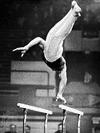- parallel bars
-
a gymnasium apparatus consisting of two wooden bars on uprights, adjustable in height, and used for swinging, vaulting, balancing exercises, etc.[1865-70]
* * *
Event in men's gymnastics in which a pair of wooden bars supported horizontally above the floor at the same height is used to perform acrobatic feats.Competitors combine swings and vaults with stationary positions requiring strength and balance, though swings and vaults must predominate. It has been included as an Olympic gymnastics event since the modern games began in 1896. See also uneven parallel bars. Performing on the parallel bars.Stewart Fraser/Colorsport
Performing on the parallel bars.Stewart Fraser/Colorsport* * *
▪ sportsgymnastics apparatus invented in the early 19th century by the German Friedrich Jahn (Jahn, Friedrich Ludwig), usually considered the father of gymnastics. It is especially useful in improving upper-body strength. The two bars, made of wood, are oval in cross section, 5 cm (2 inches) thick, 3.5 metres (11.5 feet) long, 2 metres (6.5 feet) high, and 42 cm (16.5 inches) apart. Height and width of the bars are usually adjustable.In gymnastics competition on the parallel bars, performed by men only, movements combine swings, flight elements, strength, and balance, although swings and vaults must predominate. Movements below the bars and the release and regrasping of the bars are also required. See also uneven parallel bars.The parallel bars have been part of the Olympic (Olympic Games) program for gymnastics since the first modern Games in 1896.* * *
Universalium. 2010.
